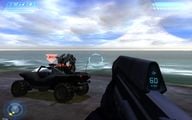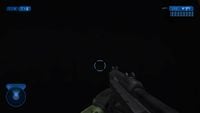Heads-up display: Difference between revisions
From Halopedia, the Halo wiki
Flood12345 (talk | contribs) (→Images) |
|||
| Line 22: | Line 22: | ||
The standard MJOLNIR armor contains the following readouts: | The standard MJOLNIR armor contains the following readouts: | ||
* A meter displaying the relative [[Health|Vitality]] of the user (absent from Halo 2 and Halo 3). | * A meter displaying the relative [[Health|Vitality]] of the user (absent from [[Halo 2]] and [[Halo 3]]). | ||
* A gauge displaying [[Shield]] integrity status. (absent from SPI armor, as they have no shields) | * A gauge displaying [[Shield]] integrity status. (absent from SPI armor, as they have no shields) | ||
* A gauge tracking the quantity of ammunition available for weapons carried. | * A gauge tracking the quantity of ammunition available for weapons carried. | ||
Revision as of 15:48, February 13, 2009

A Head-Up Display, or HUD, is a transparent display that presents data while minimising any obstruction to the user's view. Although they were initially developed for military aviation, HUDs are now used in commercial aircraft, automobiles, and other applications.
It should be noted however that the use of the term is technically inaccurate for the system used within the Halo universe, especially when describing it from an in-universe perspective. It is far more accurate to refer to the equipment as a Helmet Mounted Display, or HMD [1].
Summary
The Head-Up Display is the main source for information in-game on Halo: Combat Evolved, Halo 2 and Halo 3, though the appearance of the HUD has changed dramatically from its predecessors[1][2][3]. The sensors augmented into the Spartan's body display the soldier's vital signs, which include a measure of their overall health in the form of bars. Note that this "health bar" has been removed from Halo 2 and Halo 3, with the reason being the insertion of automatic bio-foam injectors into the Mark VI armor.[4]. In Halo 3, there a slight convex appearance to simulate looking through a real visor. Also, the MJOLNIR shields flare up in a grid-shaped pattern, to simulate the player is taking damage. Additionally, the HUD also reports the strength of the wearer's shields through the energy signatures it emanates. Weapons' heat and ammunition levels, as well as grenade type and count are also detected through sensors placed in the Spartan's gloves. In Halo 2 and 3, the Mark VI armor is able to register two weapons when the Spartan is dual-wielding.
Another notable feature on the HUD is that each type of weapon that the gloves detect has it's own unique aiming reticule in relation to the type of ammo that it projects and it's statistics. Even vehicles and known heavy weapons have their own reticules. For example, the open circle reticule on the shotgun tells you that although the shell will land somewhere in the directed area, the distance and position are rather unpredictable. Or the Ghost's reticule tells you that the plasma shots will travel as far as the two dots show, but can drift off left or right a little. The reticule is also compatible with the scope of ranged weapons when installed. However, do remember that it is a reticule that is designed to Aid the person in pinpointing where the shot will end up, while an aiming cursor shows exactly where the shot will end up.
The Motion Sensor is another important feature displayed on the HUD. It can sense and track movement in a 15 meter radius (Halo: CE), a 20 meter radius (Halo 2) and a 25 meter radius (Halo 3). Due to the insertion of IFF tags in UNSC soldiers, the radar can distinguish friend (yellow) from foe (red). Finally, the way point indicators are an on-screen directive that point out important objectives or locations in the Spartan's mission, and are extremely useful, measuring the distance the Spartan is from the objective.
A HUD display is also featured on SPI Armor, MJOLNIR armor, ODST Body Suits, Marine Body Armor, and even the Elite armor.
Confirmed Readouts
MJOLNIR armor, SPI armor, and Elite armor
The standard MJOLNIR armor contains the following readouts:
- A meter displaying the relative Vitality of the user (absent from Halo 2 and Halo 3).
- A gauge displaying Shield integrity status. (absent from SPI armor, as they have no shields)
- A gauge tracking the quantity of ammunition available for weapons carried.
- A motion tracker.
- A counter tracking the number and type of Grenades carried.
- A targeting reticule which changes relative to the weapon currently in use.
- Acknowledgment lights from other members of the wearer's team.
- Maps and information uploaded over the wearer's TACCOM.
- Zoom Function or function for using a Fiber Optic Probe (absent from gameplay).
ODST Body Suit and Marine Body Armor
The standard ODST and Marine armor contains the following readouts:
- A gauge tracking the quantity of ammunition available for weapons carried.
- A counter tracking the number and type of Grenades carried.
- A targeting reticule.
- Acknowledgment lights from other members of the wearer's team.
- Maps and information uploaded over the wearer's TACCOM.
Terminology
Although the games, novels and manuals all refer to a Head-Up Display (HUD), this is technically an incorrect description of the equipment featured in-universe. By definition, a Head-Up Display is a fixed unit where by you must look 'up' in order to see it. For example, the HUD in a fighter jet is mounted to the glareshield and cannot be moved. If the pilot looks to his left or right, he can no longer see the display.
The term HUD originally came from looking 'up' out of the cockpit as opposed to looking down at the gauges on the instrument panel.
The correct in-universe term for the equipment in the Halo games is a Helmet Mounted Display, or HMD. A display mounted or projected onto a helmets visor, the result of which being that no matter where the wearer looks, the display will remain in front of his eyes. HMD's have been in military service as early as the late 1970's when the Soviet Union was developing the MiG-29 Fulcrum and are currently starting replacing HUD's in the newest generation of fighter jets.
For example, the new Lockheed Martin F-35 Lightning II does not feature a HUD at all, instead completely relying upon the pilots HMD.
Images
HUD for MJOLNIR Mk. V, from Halo: CE.
The MJOLNIR Mk. VI HUD from Halo 2.
The new MJOLNIR Mk. VI HUD from Halo 3.
Trivia
- It is unknown how the Combat Harness-bearing Elites see their HUD due to the fact that they have no visor or digital readout. It is likely that they use eye coverings to give them their HUD.
- Custom games in Halo 3 let you be able to change how far your radar reads (10 meters, 25 meters, 75 meters or 150 meters). A downside to a large-range radar is that the red dots which represent enemies become hard to see.


